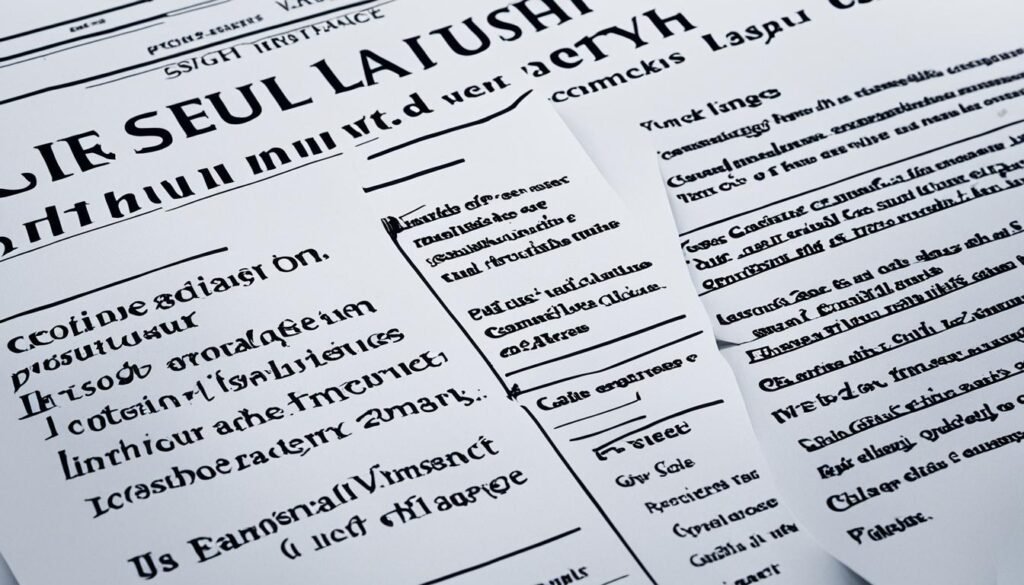Did you know about 169,936 people die in the U.S. each year because of accidents caused by others? These events, known as wrongful deaths, leave families in deep sorrow. They seek justice for their lost loved ones.
Wrongful death happens when someone doesn’t do their legal duty and causes a death. In these lawsuits, the person suing must show several things. They need to prove negligence or intentional harm caused the death and there are losses because of it.
Who can sue? Many people, like the surviving spouses, parents, or children, and other close family. Also, the person handling the deceased’s estate can file a wrongful death lawsuit. These lawsuits are against individuals or businesses and stem from either intentional acts or carelessness.
There are many types of wrongful death cases. These include crimes like murder, accidents like car crashes, or when products are unsafe. At fault could be drivers, companies, or medical professionals, among others.
There’s a time limit for filing wrongful death lawsuits, usually two years from the death. The person suing must show the defendant had a duty to keep the deceased safe, failed in that duty, and caused the death, leading to significant losses.
Key Takeaways:
- Wrongful death occurs when a person or entity fails to fulfill a legal duty and causes a death to occur.
- Surviving spouses, parents or children, other immediate family members, and a personal representative of the deceased person’s estate can sue for wrongful death.
- Examples of wrongful death cases include intentional acts, negligence, and failure to warn or defective products.
- Wrongful death lawsuits should be filed within the statute of limitations, typically two years from the date of death.
- To win a wrongful death lawsuit, the plaintiff must prove duty of care, breach of duty, causation, and damages.
Understanding Wrongful Death vs. Personal Injury Lawsuits
Wrongful death claims and personal injury lawsuits are both legal ways to seek money for harm done by someone else. While similar, they are different in some big ways.
In a personal injury case, the hurt person or the victim takes action against the person at fault. They aim to get money for injuries and losses. This can cover medical costs, lost pay, pain, and emotional distress.
But, a wrongful death claim starts when someone dies because of an accident. Here, the family or a representative of the lost one fights for justice. They aim to get money for the deceased’s medical costs, funeral expenses, lost future income, and loss of companionship.
To win in a personal injury lawsuit, the injured must show that the other’s carelessness caused their hurt. For wrongful death, it must be shown that the fault of the defendant caused the death. The proof needed is different for each case type.
In essence, personal injury cases are about getting the victim money for their harm. Wrongful death claims aim to compensate the family for their huge loss.
| Wrongful Death Lawsuit | Personal Injury Lawsuit |
|---|---|
| Filed when an accident results in a death | Filed when an accident causes injuries |
| Family or personal representative pursues legal action | Victim files a lawsuit or negotiates a settlement |
| Compensation for medical bills, pain and suffering of the deceased, funeral and burial costs, loss of future income, loss of companionship | Compensation for medical bills, lost wages, pain and suffering, emotional distress |
| Must prove defendant’s negligence or intentional act caused the death | Must prove defendant’s negligence caused the injuries |

Wrongful Death Cases: Types and Examples
Wrongful death cases cover various situations where a death results from negligence or intentional acts. By looking into the types of wrongful death cases and real-life examples, we can understand their complexities better.
Intentional Wrongful Death Cases
Examples of intentional wrongful death are murders and assaults. Here, one person’s deliberate act causes another’s death. The accuser must prove the attacker meant to harm, causing a fatal outcome.
Negligence Wrongful Death Cases
Negligence leads to many wrongful death claims. For instance, car crashes due to reckless driving, or deaths caused by faulty products. Slip and fall cases, dog bites, and construction accidents are also examples. These require showing the accused did not care as they should, leading to a person’s death.
Malpractice Wrongful Death Cases
Medical mistakes can lead to wrongful death claims too. If a healthcare provider’s carelessness results in death, it may count as malpractice. These cases need strong proof that the care was far below the needed professional standards.
Learning about wrongful death cases helps us see the wide variety of cases. The examples help highlight why it’s crucial to carefully study each case. With careful examination and solid evidence, building a strong legal case is possible.

Who Can Sue for Wrongful Death?
When someone dies because of another’s mistake or deliberate action, seeking justice is natural. But who can legally sue for wrongful death? We’ll look at who can file these lawsuits and their rights.
Usually, spouses, parents, and children of the deceased can sue. They have a close bond with the person who died and feel the loss deeply. Siblings and grandparents might also be eligible to sue in some situations.
The deceased’s estate’s personal representative can also sue. This person, chosen by a will or the court, represents the deceased legally and manages their estate’s matters.
Who can sue for wrongful death differs in each state. Check the laws in the state where the death happened to know who’s eligible. Sometimes, life partners and financial dependents can also sue.
Understanding the Wrongful Death Statute
Every state has laws on who can sue for wrongful death and how to do it. These laws also set a deadline for filing a lawsuit.
Talking to a lawyer who knows about wrongful death cases is wise. They can explain the laws in your state. A good lawyer will help you understand if you can sue and guide you in seeking justice.
| Eligible Parties for Wrongful Death Claims | Additional Considerations |
|---|---|
| Surviving Spouses | Common-law spouses may be eligible depending on state law. |
| Parents | Includes biological and adoptive parents. |
| Children | Includes biological and adopted children. |
| Other Immediate Family Members | In certain cases, siblings, grandparents, or other close relatives may have the right to file a claim. |
| Personal Representative of the Deceased’s Estate | Appointed through a will or by the court to handle the affairs of the deceased’s estate. |
Who Can Be Sued for Wrongful Death?
In wrongful death cases, many different people or groups can be responsible. This includes those who acted carelessly or on purpose. Almost anyone causing a death through these means might face a lawsuit.
Examples of who might be sued include:
- Drivers at fault for collisions
- Companies who design or manufacture defective products
- Companies or individuals who provide alcohol to impaired drivers
- Companies who fail to warn of product risks
- Designers or builders of faulty roadways
- Government agencies who do not provide warnings about dangerous road hazards
- Medical professionals who committed malpractice
- Employers of those who caused the death while performing work duties
These examples show just a few of the possible people or companies that might be involved. Each case is unique, so it’s key to talk with a lawyer. They can help identify all the possible defendants in a wrongful death lawsuit.
| Defendant | Examples |
|---|---|
| Drivers at fault for collisions | Reckless drivers, drunk drivers, distracted drivers |
| Companies who design or manufacture defective products | Automobile manufacturers, pharmaceutical companies |
| Companies or individuals who provide alcohol to impaired drivers | Bars, restaurants, social hosts |
| Companies who fail to warn of product risks | Manufacturers, distributors |
| Designers or builders of faulty roadways | Construction companies, government agencies |
| Government agencies who do not provide warnings about dangerous road hazards | Transportation departments, municipalities |
| Medical professionals who committed malpractice | Doctors, nurses, hospitals |
| Employers of those who caused the death while performing work duties | Construction companies, employers involved in workplace accidents |
Filing a Wrongful Death Lawsuit
If you think someone’s negligence or intentional act caused a death, you should talk to an attorney quickly. They can help you file a wrongful death lawsuit. This lawsuit should be submitted where the death happened.
First, you must see if you’re allowed to file and know the deadline. This deadline is often two years after the death.
To start, gather proof like medical records and witness statements. Good evidence increases your chance of winning.
Then, you must submit required documents to the court. These documents describe your case and who is involved. Make sure to fill them out right and on time.
Next, you might try to settle the case. Your lawyer will discuss with the other side or their insurance. If no agreement is reached, the case might go to court for a decision.
An experienced wrongful death attorney is vital throughout this. They know how to handle the legal system and support your case. They aim to present your case well for the best outcome.
Role of a Wrongful Death Attorney
A wrongful death attorney is crucial in these lawsuits. They guide you in many ways, like:
- Checking if your lawsuit is valid
- Investigating the death
- Collecting strong evidence
- Submitting legal paperwork
- Talking with the opposite side or insurance
- Representing you in court when needed
With a skilled wrongful death attorney, you protect your rights. They help you seek the right compensation and justice.
Conclusion
Understanding wrongful death and who can sue is key for justice. Wrongful death happens when someone fails their duty and causes a death. Usually, family or the estate’s representative may sue for damages, proving the death was caused by negligence or an intentional act.
Wrongful death lawsuits can target different parties like reckless drivers or negligent doctors. To file a lawsuit, collecting evidence and legal documents is necessary. This might lead to negotiations or a settlement. But these cases can be complex to handle on your own.
It’s critical to have a skilled wrongful death attorney by your side. They know the legal system and can fight for your rights. With their help, you can move through the legal process more smoothly and have a better shot at getting justice and compensation.

